Archery historian Hugh Soar looks at the life and work of Peter Muir, one of Scotland’s most celebrated bow makers
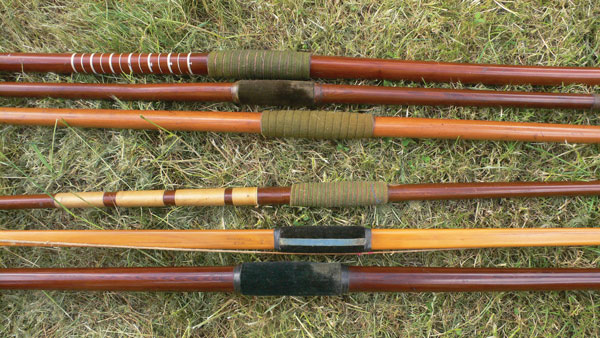
Bows by William Fergie the Elder, Andrew Gordon (two bows), William Fergie the younger, and Peter Muir himself (two bows)
Four men dominated the bow-making scene during the nineteenth century heydays of archery as a social recreation – Thomas Waring, Thomas Aldred, James Buchanan and Peter Muir. Others, principally makers of umbrellas and fishing tackle, added bowyery to their repertoires with varying degrees of success; but it was to these four that many turned for quality and quantity.
While Waring, Aldred and Buchanan serviced the English clubs and societies, in Scotland Muir reigned supreme, and this is his story.
Background
Peter Muir was born in Kilwinning, Ayrshire in February 1809, the youngest of 10 children of William Muir, carpenter and maker of bows. Kilwinning was then, as now, famed for its Papingo shoot – an activity by then over three centuries old, and firmly established as fundamental to the Scottish archery scene.
Archery among the lads was a favourite exercise, and young Peter – for whom it was an everyday activity – quickly became proficient. Boy’s targets at the butts were pieces of gingerbread and shortbread – whoever hit one and broke it ate the pieces. Peter quickly became adept at this.
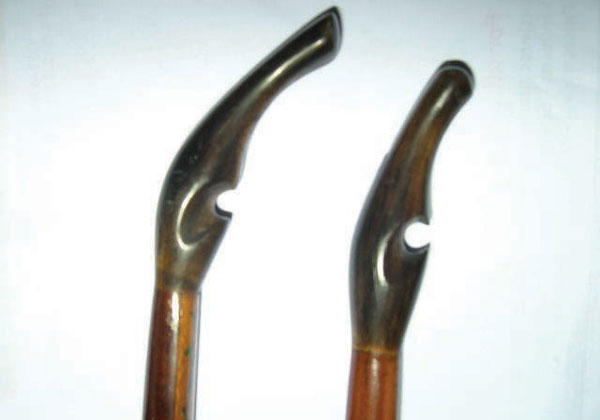
Distinctive ‘spoon’ shaped horns were a local convention Muir and his immediate successors kept going
Having left school, Peter took up an apprenticeship with his father, and it was here that he learned those skills which were to earn him respect and praise. It is conjectural, however, from whom he learned the finer aspects of his craft, for it was his uncle David Muir who seems to have influenced his style. Young Muir’s attention to detail as a meticulous workman became widely known – so widely known in fact that, in 1829, aged just 18, he was offered employment in Edinburgh by the Royal Company of Archers, the Queen’s bodyguard in Scotland.
The company’s own bowyer, John Brand, had become progressively ill and a replacement was needed. They could not have made a better choice. Young Peter settled in rapidly and quickly established a reputation for excellence that spread beyond Scotland.
In company with other top-flight bowyers Muir preferred to work with imported yew – the writer possesses 13 of his bows and seven are of self-yew. Although preferring convention, he turned occasionally to self-lancewood as an alternative and five of these in my collection attest to his working skill.
Although not known for experiment, he did once accept a quantity of African hardwood and from this came a number of self-bows. He was dissatisfied with the result however, and did not repeat the experiment. The writer has one of these, a self-bow in exotic ruby-wood.
The Muir style
Muir’s bows displayed a number of features indicative of his desire to develop a distinct Scottish style. Although a shorter length was an immediate and noticeable characteristic, three other subtleties are there to be found. In company with his English counterparts and in keeping with accepted practice, he equipped his self-yew bows with a mother-of pearl arrow-pass. With its half-moon shape, it was clearly different from the ‘steeple’ shape convention used by English bow makers. His stringing horns differed also, continuing what appears to have been a local convention for a forward-facing ‘spoon shape’ – a design retained by his immediate successors. Muir also perpetuated the belly wedge, a V-shaped cork wedge fixed above the handle and designed to safely deflect an over-drawn arrow. Much of Scottish shooting at that time was for distance, and a ‘dynamic’ or ‘slashing’ loose was the order of the day. English archers who regularly shoot clout will recognise the style, as will modern war-bowmen.
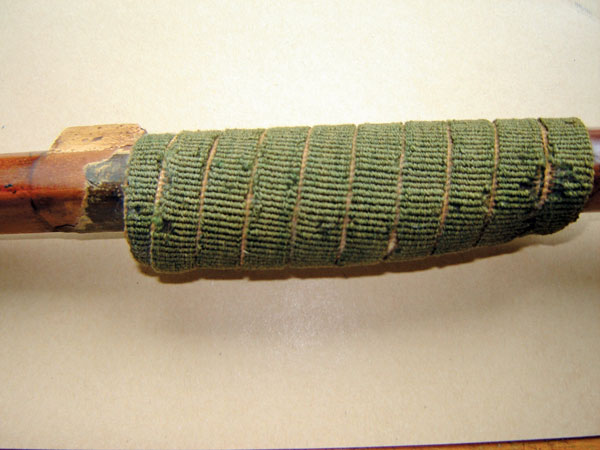
While he retained the use of mother of pearl for arrow passes, he used a half-moon rather than steeple shape, as was common elsewhere
Comparison between two men’s bows in my collection shows a similarity between those of Muir and Waring the Younger. Each is 69 inches in length and each draws 47lbs. When Waring retired in 1846 and Thomas Aldred appeared on the scene things changed. Aldred had formed a partnership which quickly went sour and he, working elsewhere full time, sought help from the nearby Purle family of bowyers. It was perhaps Purle who dictated the specification of Aldred bows, succeeding the earlier convention by increasing length and poundage; since of 21 men’s bows by Aldred in my collection all but two are between 70 and 72 inches in length. The two that differ measure 69 inches, bespoke perhaps for followers of Waring. Poundages also vary between the two makers – Muir favouring the middle 40s and Aldred the higher values.
It seems likely that the shorter Scottish bow with the marginally lighter draw-weight equalled and perhaps exceeded the potential of the longer English bow.
Muir the archer
Besides his skill as bow-maker, Muir was an excellent archer. Practice at the butts when young stood him in good stead and he quickly proved himself a worthy opponent at Grand National Meetings, taking part in these regularly between 1844 and 1878. At his debut – the first Meeting in 1844 – he made a very moderate score of 167 with just 43 hits. This improved in 1845 with 135 hits and 537 scored and he took championship medals in 1845, 1847 and 1863.
Although he was undoubtedly a good shot, his style seems to have attracted criticism from those who shot ‘scientifically’ – notably Horace Ford. Muir is said to have “imperturbable nerve and temper, and to shoot as one who has trained himself for ranges exceeding those of the York Round.” Since the Royal Company, whose members he coached, habitually shot well in excess of 100 yards, it seems likely that Muir had adopted a form of ‘slashing loose’ which distinguished him from the more sedate style of Ford’s followers.
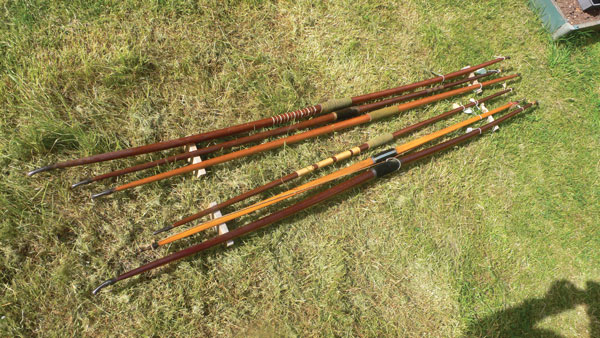
These bows were made by Muir or those who kept his style going [Fergie (Elder), Gordon, Gordon, Fergie (Younger), Muir, Muir]
As might be expected, Muir was active in Scottish archery as a member of the Edinburgh Toxophilite Club. Although he seldom shot at their Championship Meetings since he was so much better than the other members, he had no problem with shooting at occasional the Scottish National Meetings. He gained championship honours in 1863, 1865 and 1866. He evidently enjoyed target and butt shooting, and by implication clout, but one feels that he retained affection for the Papingo of his youthful Kilwinning days. Although there is no evidence that he regularly attended to shoot, he featured on the medal list in 1864, and must surely have visited often, to stand and perhaps critically to observe.
Quick to establish himself as a top flight bowyer, Peter may have been influenced along the way by his uncle, David Muir, himself a bowyer of considerable skill. A weapon by him was presented to Prince Albert – husband of Queen Victoria – by the Kilwinning Society and is now in the Royal Collection. Comparison between this bow – illustrated in Vol:50 (2007) of the Society of Archer Antiquaries Journal – and a similar example by Peter shows a number of common features.
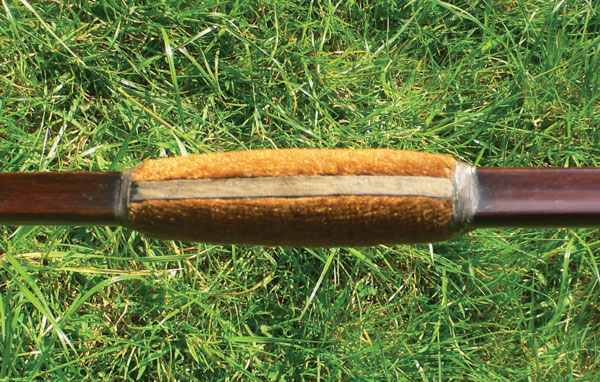
Muir would have been very familiar with the papingo tradition – here is a bow of his made for that purpose. Note the concave back
Arrow maker
Besides his reputation as a fine bow maker, Muir was also notable for his arrows, readily identifiable by their red and gold cresting and dark blue shaftments. Muir was not their maker however – that responsibility rested with one Dick Thompson, a member of the Thompson family of Meriden, hereditary bow-makers to the Woodmen of Arden. Dick held the position of fletcher to Peter Muir for 60 years. A typical Muir/Thompson gentleman’s arrow would be of pinus, and weigh 4s 6d against silver coinage. It would be 28 inches in length, lightly barrelled in profile, with a six inch ‘two point’ footing in hardwood. A parallel metal sheathed pile with stopping would arm it, and it would be fletched with four-inch turkey feathers cut triangular. It had a full buffalo-horn nock. Its spine deflection suited a 49lb bow.
Regarding spine: although length, profile and weight were carefully controlled, ‘spine’ as we know it today was not controlled or even fully understood. ‘Stiffness’ was by gauged by flexing in the hands and whippiness (spine) decided thereby.
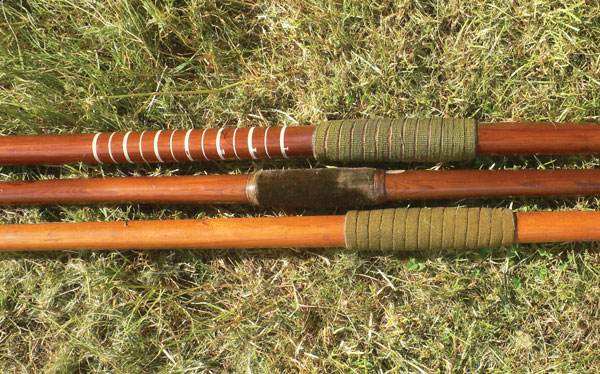
Peter Muir was apprenticed as a bowmaker to his father, before becoming the official bowyer to Scotland’s Royal Company of Archers
While Peter was content to leave his arrows in Dick’s hands, he was fully knowledgeable about their ballistic properties, and there is no doubt that he maintained a watching brief. Certainly on one occasion he entered a general debate to good effect. Dr McGrigor Croft, a respected engineer, but with limited archery knowledge, had designed and patented a helically fletched shaft, dedicated – with permission – to Princess Alexandra, daughter of Queen Victoria. Called the ‘Alexandra Arrow,’ it was marketed as a great improvement on current shafts and fletching profiles. Comment was decidedly mixed; the ladies liked it since its trajectory was straighter, but the men found that its increased drag altered points of aim. Conflicting opinion raged on for a while, until Muir stepped in to question the patent, reporting that many years ago he had tried the system and had dismissed it as a gimmick.
Peter Muir retired in 1885 after 60 years of dedicated service, his reward for dedicated service a truly ‘golden handshake’ of 450 sovereigns and a splendid silver plate. Although the ‘master’ had passed away, his two principal assistants, William Fergie the Elder, and Andrew Gordon, remained. Significant bowyers in their own right, in tribute each prominently marked their work ‘Late Muir’. And so did the spirit of Scotland’s greatest bowyer live on.
This article originally appeared in the issue 117 of Bow International magazine. For more great content like this, subscribe today at our secure online store www.myfavouritemagazines.co.uk


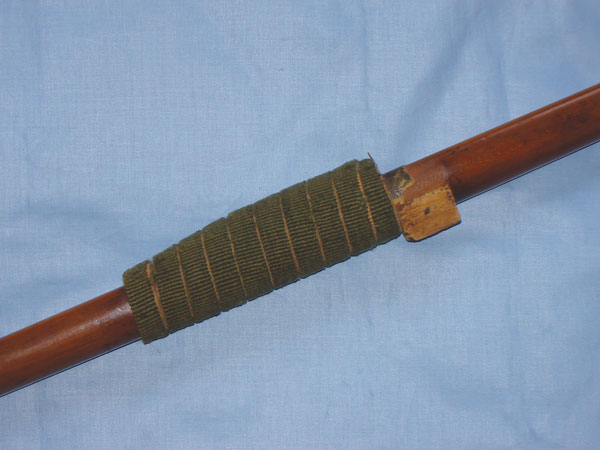
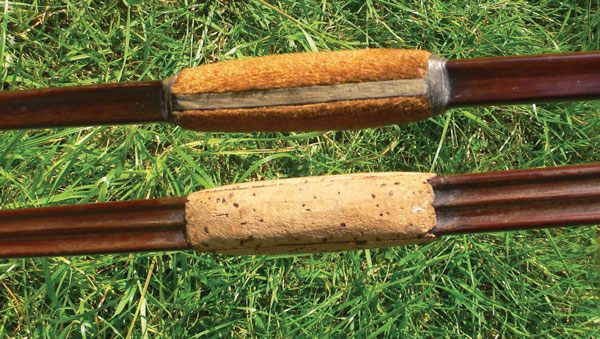
Dear Mr Soar, I am interested in the link between bowyers and golf club makers in the 19th century. Do you have any knowledge as to where James Buchanan was born and trained? I understand that he went to London in 1840, and I ahve come across clubs made by him and sold from his shop at 215 Piccadilly. I wonder where he learnt his club making skills?
Regards, Mungo Park
Hi Mr Soar
Peter Muir was my great great grandfather. I have several of his bows and also the silver tray presented at his retirement.
The date on the tray is 1878 and the engraving says ” after more than 50 years service. I have some other bows including a very heavily decorated one,and three bow cases, two of which have placement for 24 arrows.Some of my arrows are by Aldred